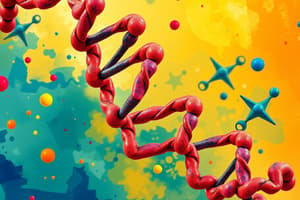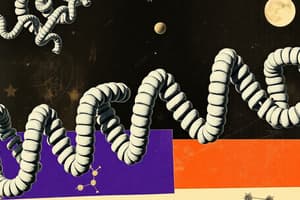Podcast
Questions and Answers
What is the primary role of proteins in the body?
What is the primary role of proteins in the body?
- To store genetic information
- To provide form and support (correct)
- To synthesize carbohydrates
- To transport water
What is a dipeptide?
What is a dipeptide?
- A single amino acid
- A long chain of amino acids
- A type of globular protein
- Two amino acids linked by a peptide bond (correct)
Which type of protein is primarily structural and protective?
Which type of protein is primarily structural and protective?
- Nucleoproteins
- Lipoproteins
- Fibrous proteins (correct)
- Globular proteins
What structural feature is characteristic of the secondary structure of proteins?
What structural feature is characteristic of the secondary structure of proteins?
Which of the following describes the tertiary structure of a protein?
Which of the following describes the tertiary structure of a protein?
Which type of protein is composed of amino acids and carbohydrates?
Which type of protein is composed of amino acids and carbohydrates?
What is the function of hemoglobin in relation to proteins?
What is the function of hemoglobin in relation to proteins?
Which nucleotides pair with each other in DNA?
Which nucleotides pair with each other in DNA?
¿Cuál es la principal diferencia entre las proteínas fibrosas y las globulares?
¿Cuál es la principal diferencia entre las proteínas fibrosas y las globulares?
¿Qué tipo de enlaces se forman entre los aminoácidos en las proteínas?
¿Qué tipo de enlaces se forman entre los aminoácidos en las proteínas?
¿Cuál es la función de las proteínas motoras como la miosina y la actina?
¿Cuál es la función de las proteínas motoras como la miosina y la actina?
¿Qué caracteriza a los heteroproteínas?
¿Qué caracteriza a los heteroproteínas?
La estructura terciaria de una proteína se caracteriza por:
La estructura terciaria de una proteína se caracteriza por:
¿Cuál de las siguientes no es una función de las proteínas?
¿Cuál de las siguientes no es una función de las proteínas?
¿Cómo se caracterizan los compuestos que forman los nucleoproteínas?
¿Cómo se caracterizan los compuestos que forman los nucleoproteínas?
¿Cuál de las siguientes afirmaciones sobre los aminoácidos es correcta?
¿Cuál de las siguientes afirmaciones sobre los aminoácidos es correcta?
Flashcards are hidden until you start studying
Study Notes
Proteins
- Macromolecules built from amino acid monomers
- Essential components of cells and tissues
- Water-soluble and large in size
- High molecular weight
- Continuous amino acid supply is necessary for protein synthesis
- Dietary protein is crucial for meeting the body’s amino acid demands
Primary Structure
- Amino acids link through peptide bonds
- Two amino acids form a dipeptide
- Longer chains of amino acids create polypeptides
- The protein’s specific number and sequence of amino acids determines its unique folding pattern.
Fibrous Proteins
- Form elongated structures
- Function as structural and protective components
Globular Proteins
- Compact, spherical structures
- Soluble in water or polar solvents
- Involved in cellular functions
Heteroproteins
- Composed of amino acids combined with other compounds:
- Glycoproteins: Amino acids + carbohydrates
- Lipoproteins: Amino acids + lipids
- Phosphoproteins: Amino acids + phosphates
- Chromoproteins: Amino acids + pigments
- Nucleoproteins: Amino acids + nucleic acids
Secondary Structure
- α-Helix: Coils around itself, facilitated by hydrogen bonds between amino acids, forming a helix-like structure
- β-Sheet: Takes on a folded sheet appearance
Tertiary Structure
- Combines amino acid sequences and secondary structures (α-helix and β-sheet)
Functions of Proteins
- Structural: Provide form and support (e.g., collagen in tissues, elastin, keratin)
- Transport: Carry oxygen to cells, transport iron (e.g., hemoglobin)
- Defensive: Strengthen the immune system
- Enzymatic: Accelerate chemical reactions
- Motor: Myosin and actin regulate muscle movements
- Regulatory: Histones and cyclins
Nucleic Acids
- Transmit hereditary information, determining the proteins produced by a cell
- DNA (deoxyribonucleic acid)
- RNA (Ribonucleic acid)
- Polymers constructed from long chains of nucleotide molecules
DNA Structure
- Double helix structure
- Composed of the bases adenine, guanine, cytosine, and thymine
- Guanine pairs with cytosine
- Adenine pairs with thymine
- Connected through hydrogen bonds
Proteins
- Large molecules made from amino acids
- Essential for structure, function, and regulation of cells and tissues
- Soluble in water
Amino Acid Chains
- Amino acids linked by peptide bonds
- Two amino acids = dipeptide
- Longer chains = polypeptide
- Specific amino acid sequence determines protein shape and function
Protein Structures
- Primary Structure: Sequence of amino acids
- Secondary Structure: Folding patterns within the polypeptide chain:
- Alpha helix: Coiled shape due to hydrogen bonds
- Beta sheet: Folded sheet structure
- Tertiary Structure: Overall 3D shape of the protein, determined by interactions between amino acids and the environment
- Quaternary Structure: Multiple polypeptide chains interacting to form a functional protein
Protein Types
- Fibrous Proteins: Elongated, structural and protective (e.g., collagen, keratin)
- Globular Proteins: Compact, spherical, involved in cellular processes (e.g., enzymes, antibodies)
- Heteroproteins: Composed of amino acids and other molecules:
- Glycoproteins: Carbohydrates
- Lipoproteins: Lipids
- Phosphoproteins: Phosphates
- Chromoproteins: Pigments
- Nucleoproteins: Nucleic acids
Functions
- Structural: Provide support and shape
- Transport: Carry molecules throughout the body
- Defensive: Immune system components
- Enzymatic: Catalyze chemical reactions
- Motor: Movement and contraction
- Regulatory: Control cellular processes
Nucleic Acids
- Carry genetic information and direct protein synthesis
- DNA: Deoxyribonucleic acid
- RNA: Ribonucleic acid
- Polymers composed of nucleotides
DNA Structure
- Double helix structure:
- Two strands of nucleotides twisted around each other
- Bases pair: Adenine (A) with Thymine (T), Guanine (G) with Cytosine (C)
- Hydrogen bonds connect base pairs
- Contains genetic code for protein synthesis
- Located in the nucleus of cells
RNA Structure
- Single strand of nucleotides
- Uses Uracil (U) instead of Thymine (T)
- Involved in protein synthesis and other cellular processes
Studying That Suits You
Use AI to generate personalized quizzes and flashcards to suit your learning preferences.




